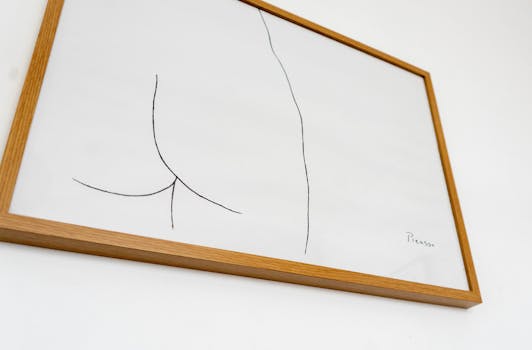Pablo Picasso: Master of Modern Art

Pablo Picasso stands as one of the most influential figures in 20th-century art, known for his revolutionary contributions to modern art. Born in Málaga, Spain, in 1881, Picasso exhibited prodigious talent from a young age. His career spanned over seven decades, during which he continually reinvented his style and explored various mediums, including painting, sculpture, ceramics, and printmaking. Picasso's work not only defined the artistic movements of his time but also challenged traditional notions of representation and aesthetics.
Early Life and Education
Pablo Picasso was born on October 25, 1881, to José Ruiz Blasco and María Picasso López. His father was an art teacher and painter who recognized Pablo's exceptional talent early on. At just seven years old, Picasso began formal training under his father's guidance. By age 13, he had already surpassed his father's skills.
In 1895, Picasso's family moved to Barcelona, where he enrolled in the La Llotja School of Fine Arts. Despite his young age, he quickly gained recognition for his unique style and technical proficiency. He later moved to Madrid to attend the Royal Academy of San Fernando but found the formal education restrictive and soon returned to Barcelona.
Picasso's early works were heavily influenced by classical techniques and subjects. However, his exposure to avant-garde movements in Paris during visits in the early 1900s began to shape his distinctive approach to art.
The Blue and Rose Periods
Picasso's career is often divided into distinct periods, each marked by significant stylistic changes. The Blue Period (1901-1904) was characterized by somber tones and melancholic themes, reflecting his emotional state following the suicide of his close friend Carlos Casagemas. During this time, Picasso primarily used shades of blue and depicted subjects such as beggars, street performers, and prostitutes.
The subsequent Rose Period (1904-1906) saw a shift to warmer colors and more joyful themes. Influenced by his relationship with Fernande Olivier and the vibrant circus life in Paris, Picasso began incorporating pinks and reds into his palette. This period also marked the beginning of his experimentation with more abstract forms.
Cubism: A Revolutionary Movement
One of Picasso's most significant contributions to modern art is the development of Cubism alongside Georges Braque. Beginning around 1907, Cubism broke away from traditional perspectives and depicted objects from multiple viewpoints simultaneously. This radical approach challenged conventional representation and laid the groundwork for many subsequent modern art movements.
Picasso's "Les Demoiselles d'Avignon" (1907) is often considered a pivotal work in the development of Cubism. The painting features five female nudes rendered in fragmented geometric shapes, drawing inspiration from African masks and Iberian sculpture. This innovative technique was further refined in works like "Girl with a Mandolin" (1910) and "Three Musicians" (1921).
- Analytical Cubism: Focused on deconstructing objects into geometric forms.
- Synthetic Cubism: Emphasized simpler shapes and brighter colors.
Later Works and Legacy
Throughout his career, Picasso continually evolved his style and experimented with different media. In the 1920s, he became involved with Surrealism, producing works that explored dreamlike imagery and subconscious themes. His famous painting "Guernica" (1937), created in response to the bombing of the Basque town during the Spanish Civil War, stands as a powerful anti-war statement.
In addition to painting, Picasso ventured into sculpture, ceramics, and printmaking. He collaborated with renowned artists like Henri Matisse and Joan Miró while maintaining a prolific output until his death in 1973.
| Period | Years | Characteristics |
|---|---|---|
| Blue Period | 1901-1904 | Somber tones, melancholic themes |
| Rose Period | 1904-1906 | Warmer colors, joyful themes |
| Cubism | 1907-1914 | Geometric forms, multiple perspectives |
| Surrealism | 1920s-1930s | Dreamlike imagery, subconscious themes |
| Latter Years | 1940s-1973 | Diverse styles, continued innovation |
Ted Talk Insights: The Enduring Influence of Picasso's Work
A recent TED Talk by art historian Dr. Samantha Matthews delved into Picasso's enduring influence on modern art (ted.com). Dr. Matthews highlighted how Picasso's relentless experimentation paved the way for contemporary artists to break free from traditional constraints.
According to Dr. Matthews, one key aspect of Picasso's legacy is his ability to constantly reinvent himself while staying true to his artistic vision. She emphasized that this adaptability is what makes Picasso's work relevant even today. His pieces continue to inspire artists across various genres and disciplines.
The Personal Impact: Connecting with Picasso’s Art
For many art enthusiasts like myself, engaging with Picasso's work can be a deeply personal experience. Visiting exhibitions featuring his pieces offers an opportunity to witness firsthand the evolution of his style over decades. Each period reveals different facets of his personality and artistic journey.
The emotional depth conveyed through paintings like "The Old Guitarist" from the Blue Period or "Family of Saltimbanques" from the Rose Period resonates with viewers on a profound level. These works evoke empathy and reflection on human experiences such as sorrow, joy, struggle, and triumph.
Pablo Picasso remains a towering figure in modern art whose influence transcends time and geography. From his early academic training under familial guidance to pioneering Cubism alongside Georges Braque – every phase of his career contributed significantly towards shaping contemporary artistic expressions globally.
The TED Talk by Dr. Samantha Matthews underscores how vital it is for current generations not only appreciate but also learn from past masters like Picasso whose revolutionary spirit continues inspiring innovation within creative fields worldwide (ted.com). As we reflect upon this iconic artist’s legacy – let us celebrate enduring power creativity holds transforming perceptions reality itself!